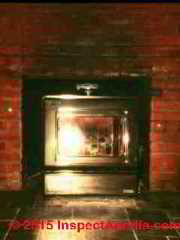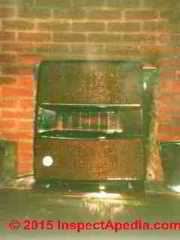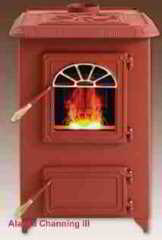How to Start a Reading Coal Stove
 Coal Stove Installation & Performance
Coal Stove Installation & Performance
Coal stove controls & draft
- Post a QUESTION or Annotate about dampers, fire/smoke dampers, duct dampers, vibration dampeners, or burn dampers or flue controls or HVAC duct controls
InspectAPedia tolerates no conflicts of interest. We have no relationship with advertisers, products, or services discussed at this website.
Coal Stove choices, installation, performance, & safety:
This article discusses the isntallation and operation of coal stoves used equally heating appliances in buildings. Nosotros include details almost heat output control and draft regulation.
The article links to additional details providing coal stove burn cleareances, chimney safety and coal stove sources, repairs, fuel costs, & related research.
We also provide an ARTICLE Index for this topic, or you can try the page top or bottom SEARCH BOX as a quick style to detect data you need.
Coal stove dampers & draft control
Coal fueled heaters utilise manual dampers in the coal stove flue or for larger and automatically-fed coal fired boilers or furnaces the organization may comprise a thermostatically-operated automatic flue damper to control both draft and thus the system's oestrus output.


The coal stove shown at above left was installed past the author (DF) in the 1970's. A slider along the stove bottom permitted the user to conform the air intake rate - a necessary combustion and heat control since the installation of this stove in front of a pocket-size fireplace gave no admission room for a flue damper control.
The 2d fireplace-inserted heater at above correct is a coal stove that was designed to likewise burn forest. This woods/coal heater, installed by Paul Galow in New York in the 1970's, also had a sliding air intake control and no accessible flue damper.
The vertical lines you lot see in the drinking glass front of each of these coal burners immune the installation of glass that would not fracture due to thermal expansion, allowing the occupants to relish watching the fire. Yes ultimately these get broken past a careless occupant or user, putting the stove out of use until the drinking glass could be replaced.
Watch out: if the incoming combustion air cannot be shut downwardly because of leaky coal stove gaskets or other damage similar the broken glass in the coalstove door, the coal stove is unsafe as its burn-rate cannot exist regulated.
Run into CHIMNEY Burn down Activity / PREVENTION
Also see Burn down CLEARANCES WOOD & COAL STOVES
Reader Question: can I put to barometric dampers on the aforementioned flue along with a manual one on my Alaska Channing 3 Coal Stove?
 (December 14, 2014) Nib said:
(December 14, 2014) Nib said:
I have a Alaska channing 111. My barometric damper is 6 in then [the flue vent connector goes to viii in to connect ] to massonary chimney.
Information technology seems I need two dampers. I installed a manual damper to help
My question is can I put 2 baro dampers in the same flue to control proper draft
Cheers, Bill
Reply:
Bill
The Alaska Channing III is a coal stove (shown at left) designed to burn rice coal and with a BTUh output of 5,000 to 85,000 BTUh. That heat output capacity is controlled in function past controlling the fire charge per unit past controllinb combustion air.
Rut command for this coal stove is provided either by a manual control to accommodate heat output (basically you're adjusting the input air menstruum rate), or by a wall-mounted thermostat system that operates in two heat output ranges (low burn and loftier burn down).
As long as the single barometric damper is properly adapted and capable of opening to permit enough air intake to keep the typhoon at the desired level information technology would be fine. If the damper were not capable, such equally in an surface area of very high winds creating unusual drafts over a chimney summit, the solution would probably include
Watch out: I infer from your question that you are getting likewise much heat or that the coal stove seems to be overheating. This condition tin can be dangerous and in fact in extreme cases (such as leaving the coal stove door ajar with a fire called-for) you can warp and ruin the stove or fifty-fifty crusade a house fire.
It should not be necessary to install ii barometric dampers on a heating apparatus unless you are facing very unusual draft control issues. Nothing I read about this coal stove suggests that it would endure from excessive typhoon. In fact the company notes that ability vents can be used with their equipment (creating a withal-stronger typhoon) and that some models including the Channing Three rear vent can be direct-vented (with no chimney).
Installing 2 dampers is not something I'd recommend as adjusting them would probably exist difficult, adding complication that should not be necessary. It's like adding complication to try to solve a trouble rather than agreement the problem first.
If your coal stove is overheating check these details
- Coal Stove Installation & Safe: Check that you have installed the stove co-ordinate to the visitor's instructions. In virtually jurisdictions installing a coal stove requires a building permit, safety inspections, and of form compliance with combustion clearance and other safety guidelines.
- Coal Stove Fuel: Check that you are burning merely the fuel recommended by the manufaturer. Your Channing 3 coal stove is designed to burn only pea-coal. If y'all are burning woods pellets the result is dangerous: a hopper fire. (The company does have a dissimilar stove model that can burn wood pellets).
- Coal Stove Operation & Openings: Check that the coal stove door or other openings are properly closed and that all gaskets are in identify and not leaking. If y'all set combustion air inlet control(due south) to their almost-closed position and the stove burn down does not ho-hum accordingly then it's likely that there are air leaks into the stove and it should not be used.
- Coal Stove Heat Controls: Bank check that yous have properly set the manual or thermostatically-controlled thermostat to control the heat output of the coal stove and confirm that the heat control is working. This means turn the heat command to its lowest setting. The fire should get very low or small-scale. To completely turn off the a stove that uses a power vent it may also exist necessary to un-plug or plow off the vent fan.
- If you are using the manual thermostat (the "Motorcar Heat Command Box") and yous set temperature down cheque that indeed the coal burn down slows (air input is reduced).
- If y'all are using the wall-mounted room thermostat system bank check that the air damper on the stove is responding to changes chosen for past the thermostat.
- Chimney connection for coal stove: You lot cannot safely share a chimney flue to which a coal stove is connected with other heating appliances. Doing and then risks dangerous fire spread, carbon monoxide hazards, backdrafting and other operating problems too equally of course building code violations. Exist sure that a properly designed chimney cap is on the summit of the flue
- Coal Stove Draft Regulation: Install a single barometric damper on the larger diameter flue department as the visitor recommends.
The company does recommend the use of a barometric damper on the Alaska Channing Three when information technology is connected to a chimney to overcome excess draft caused by site conditions such every bit air current, outdoor temperature changes and changes in barometric pressure (the to the lowest degree of these forces). Regulating the draft gives more complete combustion, more fifty-fifty heat output, and more than efficient apply of your coal fuel.
To obtain an installation & operation manual for your Alaska Channing III coal stove, contact the
- Alaska Stove Visitor, 3162 Columbia Blvd. Bloomsburg, PA 17815
Tel: USA 570-387-0260
Website: www.alaskastove.com
Lookout out: if the flue damper rusts or becomes damage it may be impossible to slow the chimney draft, resulting in an over-heating stove and mayhap a chimney or house fire. Though questionable burn clearances and accumulated creosote may have been factors, just such a runaway wood stove burn down and its disastrous results are illustrated
at CHIMNEY FIRES & WOOD STOVE Prophylactic
...
Continue reading at Fire CLEARANCES, WOOD COAL & PELLET STOVES or select a topic from the closely-related articles below, or encounter the consummate Commodity INDEX.
Or come across these
Recommended Articles
- CHIMNEY CODES for downloadable copies of common chimney and appliance venting codes and standards
- CHIMNEY CODES & STANDARDS - dwelling
- CHIMNEY SAFETY, Forest BURNING - CPSC
- COALSTOVE Draft CONTROL
- COAL STOVE Functioning & Safety
- CREOSOTE DEPOSITS, FIRE HAZARD
- DRAFT INDUCER FANS
- FIRE CLEARANCES INDOORS
- Burn CLEARANCES, Woods COAL & PELLET STOVES
- PYROLYSIS EXPLAINED
- SHARED CHIMNEY & FLUE HAZARDS - home
- SHARED CHIMNEY FLUES OK
- Forest-OIL COMBINATION HEATERS
- WOOD STOVE Functioning & SAFETY
Suggested citation for this spider web page
COAL STOVE Operation & Safe at InspectApedia.com - online encyclopedia of building & environmental inspection, testing, diagnosis, repair, & problem prevention communication.
Or meet this
...
Ask a Question or Search InspectApedia
Try the search box only below, or if you prefer, mail service a question or comment in the Comments box below and we will answer promptly.
Search the InspectApedia website
Note: appearance of your Comment below may be delayed: if your comment contains an image, web link, or text that looks to the software equally if it might be a web link, your posting will appear afterwards information technology has been canonical by a moderator. Apologies for the delay.
Technical Reviewers & References
Click to Bear witness or Hide Citations & References
Publisher InspectApedia.com - Daniel Friedman
Source: https://inspectapedia.com/heat/Coal_Stove_Operation.php
0 Response to "How to Start a Reading Coal Stove"
Post a Comment